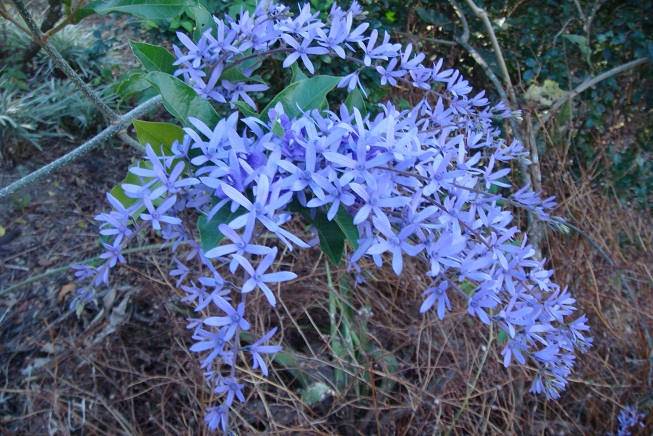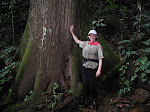This is a photo of our tree-planting squad: Armando, Armando Jose, Danny and, making his
first appearance, little Byron. We
waited until more reliable rainy weather to plant the Cenizaro trees out in
pastureland, where they will have one good growing season before the next dry
season puts their survival to the test. These
trees will join many dozens of hardwood trees already planted over the last several
years and growing well. We already have
numerous mature Guayaquil trees growing throughout the forest but, after years
of searching, realized that El Tigre hosted absolutely no Cenizaro trees at
all! So, we decided to remedy this with
the kids today!
Here is a shot of Byron and me after planting his Cenizaro
tree, which will soon tower over both of us.
We showed the kids how to tell the difference between Cenizaro and
Guayaquil trees, as even experts get them confused. It’s easy to identify them while in flower,
however: Cenizaro has pink flowers and Guayaquil
has creamy yellow flowers. When not in
flower, it’s much more difficult. We
showed the kids that the Guayaquil has a gland in the middle of the petiole,
which is absent in the Cenizaro. As with
all Mimosas, both trees have alternate, bipinnate leaves with stipules, but we
have found that other differences in the bark and leaflets can vary hugely out
in the field, so are not always reliable indicators. The key to distinguishing between Guayaquil
and Cenizaro is noting that gland in the center of the petiole= Guayaquil (Albizia guachapele,syn. Pseudosamanea guachapele, F. Fabaceae-Mim.); no gland = Cenizaro (Albizia saman, syn. Samanea
saman, F.Fabaceae-Mim.).
This is a shot of Danny and Byron with the dogs. Byron learned quickly during this outing that
you need to watch where you stand! If
you stand on an anthill, the ants will soon climb up under your socks and bite
you! So, we had to clean the ants off him and sooth his bites with a cooling
herbal lotion. However, soon he was
distracted playing with the dogs and enjoying the scene again. Lesson learned. And, with no further mishap, we planted all
five Cenizaros in different types of soil and locations in the
pastureland. The kids will now measure
the differences in the growth of the trees over the years, as yet another
ongoing experiment.
This shot shows Armando and Armando Jose with one of the newly
planted Cenizaro trees. They will join
many others in the Mimosa sub-family of Fabaceae growing nearby – Guanacaste
blanco (A. niopoides), Gavilancillo (A. adinocephala), Guanacaste, Acacia species, Cojoba arborea, Ingas, Lysilomas, and Sotacaballo (Zygia longifolia). The kids planted this particular tree in
rich, forest humus in full sun, and my bet is on this one for the fastest,
healthiest growth. However, Nature has thrown
curve balls many, many times in the past, and we can only wait and see –
observe and document. Thus, we teach the
kids the scientific method – hypothesize, and then experiment to test the hypothesis.
And, if the experiment does not confirm the hypothesis, as often happens, we
learn from that too. Every trip out in
the field, we like to check on trees planted years back and see how the forest
changes, as fast-growing trees shade out the lower growth. Where we once saw lots of Chan and Tuete
plants, we now see faster growing trees towering above them.
And the fastest growing tree of them all, Robin and I agree,
is Cecropia. Here’s a silhouette of a
Cecropia growing just below the house, which volunteered itself by seed less
than five years ago. Yet already it
towers above everything else. If you
want fast-growing trees for secondary growth besides species of Cecropia, choose
Balsa, Cupania, Luehea, Miconia, Psidiums, Sapiums, Vismia, Guazuma,
Guachepelin, Tecoma stans, Trichilias, and many legumes, like Madero negro,
Cojoba, Sennas and others. However, keep
in mind that some legumes grow very, very slowly – e.g. Cocobolo (Dalbergia
retusa), Cristobal (Platymiscium pinnatum) and Nazareno (Peltogyne purpurea) amongst
others. As a general rule for trees: the harder the wood, the slower the
growth. However, both types of trees are
important for the ecosystem: the fast-growing,
abundant-seeding but short-lived softwood trees provide humus for the slower-growing
trees nearby. But don’t forget that all these trees that I’ve been
mentioning are forest trees or, at least, for very large gardens. If you have a small garden, choose fruit
trees, and blend them with ornamental and edible plants. It’s so much more fun
to wander about the garden, if you can pick berries, fruits and herbs along the
way. As organic gardeners, we need to
mix it all together anyway to confuse the plant-chomping pests but it doesn’t
have to look chaotic if you design it carefully. I normally don’t design anything but, after allowing
Nature time to do her thing, the groupings all start to blend and harmonize
together, with a minimal effort of selecting out. There is a good reason for allowing ‘weeds’
to join the groupings too: to attract
pests away from the other plants. Tuete
(Vernonia patens) is an excellent cover plant, which attracts and tolerates pests,
thereby keeping them away from other nearby plants. Also, Tuete has well-known coagulant
properties, which we use occasionally for first-aid with the animals.
Here is a shot of a huge Granadilla, next to a red bell
pepper for perspective. Currently from
our gardens here, we’re bringing in our first big harvests of avocados, mangas,
sour citrus, Moras (thank you Hugo), Bolsas de Amor, and Chaya; and this new bounty
now joins the basketfuls of greens and vegetables that Armando has been bringing
in weekly from the more established plantings.
And, what joy, down in our experimental garden in the horse pasture, we
have finally begun harvesting asparagus, after waiting three years for the
plants to mature! Soon we will feast on this
succulent vegetable, even though it does impart a noticeable odor to one’s
urine…
Village news: After
waiting nearly four years for the road between Ciudad Colon and El Rodeo to be
fixed after the last devastating landslide, it finally began last week. However, last night, part of the works
collapsed, and now the road is completely closed for at least a week, as it is
too dangerous to pass! This means that
we are marooned here unless we take the very long route through Piedras Negras,
Jaris, etc. almost to Puriscal…
Meanwhile, construction
on the new village Salon Comunal began several months ago, despite the perilous
road, and work will begin soon on the new elementary school designed by the
famous architect, Piano. At least, that
was the plan until last night!
What’s more, fundraising is now underway for the design and
construction of a new village Catholic Church.
Yes, we all love the current picturesque church of El Rodeo, but many
residents would prefer a new church in the center of the village, rather than
make the long trek to the current one.
Nevertheless, we all hope that the existing, charming little church
shall always grace the winding road to El Rodeo. 






































